Nothing tastes as good as thin feels. Marilyn Monroe was Jell-o on springs. Harsh mantras that plague the warped minds of frustrated teenage girls in Wendy MacLeod’s Schoolgirl Figure, like those just mentioned, are what fuels this black comedic drama forward at Cohesion Theatre Company this season. Refusing to be weighed-in as an ‘issues play’ under the sharp and succinct visionary approach of Director Jonas David Grey, though MacLeod’s work does address eating disorders, it does so with a tongue-in-cheek irreverence to showcase the absurd measures to which human beings— in this case teenage girls— will go to get what they want, or die trying. No longer pushing the envelope when it comes to comfort zones, but rather forcing it over a slippery slope with a heavy hand, the production is a precarious balancing act of how to glorify MacLeod’s unique style of writing, character and plot development, and overall satiric approach to grave matters, against the sensitivity required to present such a play with the level of reverence required to keep it from being wholly offensive.
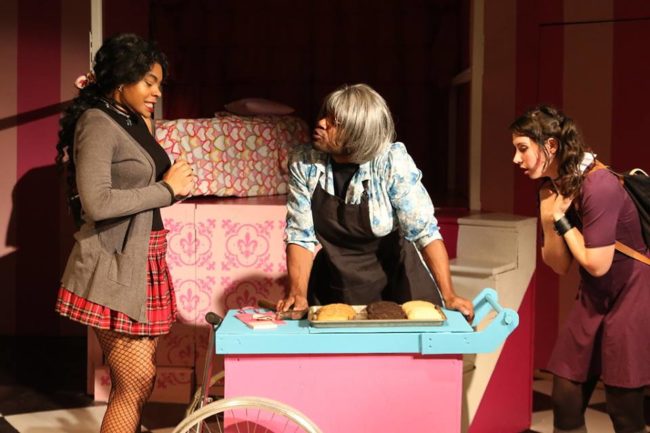
The initial visual exposure of Scenic Designer Cassandra Dutt informs the audience of our characters before they ever make their appearance. Bathed in various shades of pink, looking a bit like Barbie threw-up on the scenery, Dutt uses this color to enhance the stereotype that MacLeod has ingrained into her characterization of these teenaged, image-obsessed girls. Director Jonas David Grey, who serves as the show’s Audio and Visual Designer, uses Dutt’s design work to support his overall approach to the play. Smart and bitingly clever music videos are featured in the pre-show screening, projected against one of the set’s main walls, complimenting this outlook that Dutt hones in on in her scenic design. Grey’s use of Karen Carpenter songs throughout is symbolically appropriate as well, really giving the show that extra kick of brutal irony it deserves.
MacLeod’s play is witty, though having such a subject matter can make it difficult to digest. As Grey states in his director’s note, this cannot be viewed or experienced like an ‘issues’ play otherwise it loses a great deal of MacLeod’s intention behind her writing. There are lines, like “treating a body with respect” in reference to handling a corpse, which land with heavy double-entendre because of the characters that are saying them which would be completely lost if the play were treated gravely. The conversation that Grey attempts to start with MacLeod’s work is a bold one, largely because it’s an examination of the human condition wherein there is a ruthless drive that can be stopped by nothing— not even reason and logic— to go after the things we believe we want or deserve.
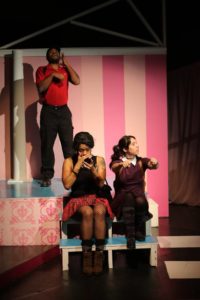
While the fact that eating disorders are prominently featured in the work cannot be overlooked, it is presented in such a way that it becomes a framing vessel for this almost Shakespearean drama. The characters are ruthless, self-centered, warped individuals who will stop at nothing to achieve what they want, much like every great Shakespeare tragedian in the Bard’s canon. Grey meticulously focuses on these monstrous traits within the characters rather than attempting to humanize them and it serves his overall vision of the production divinely.
While the play clips along with visceral jokes that dare to gut and slice into the core of human acceptance, a great many of which you might find yourself laughing at but refusing to laugh aloud for fear of being insensitive, there is a profoundly striking finale that Grey delivers with the way he presents the final moment. After nearly two hours of dark humor, this severe moment is a brutal punch to the gut which gives the entire experience a new twist and really makes one process the play as a whole before being able to attempt to digest it. There are dozens upon dozens of nuanced moments that Grey includes in his focal points from plot plateau to plot plateau, connecting them with fine threads of tension and shock, which really gives MacLeod’s work the boost it needs to be experienced for what it’s meant to be.
In addition to all of Grey’s directorial guidance, his inclusion of the ‘Tribunal’ as a harrowing hybrid of ghosts from the beyond meets digital possession is rather edgy. Styling these girls who have passed from their eating disorders into ghoulish shades of their former selves, baring striking resemblance to the demon girl from The Ring, Grey makes their malevolent presence palpable even from the projection screen. The irony therein lies that only the girls affected by these psychological disorders which affect their eating can see and hear them. This, among many other features of the play, shows how thoroughly Grey has lived with the work before exercising it onto the stage.
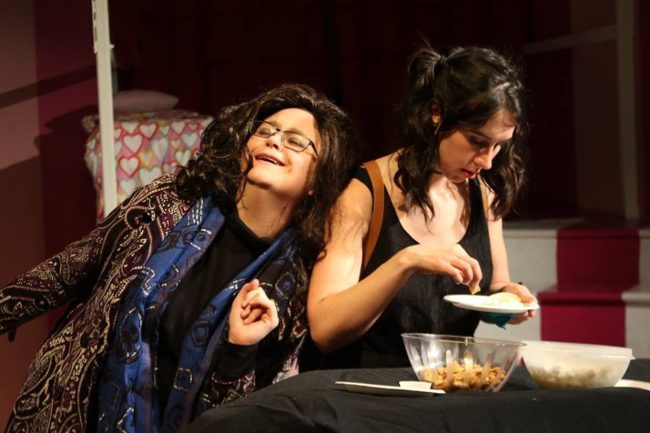
The pacing moves and cameo characters are as important as principles in this black comedy. Jane Jongeward, who is featured briefly at the beginning of the show as Monique, (appearing later as Monique’s disembodied walking ghost) and again momentarily as the Guidance Counselor, is a strong addition to the cast. Jongeward, when playing Monique, shows the intensity with which such thoughts can unravel the mind, gasping out with the character’s dying breaths to remember certain things which will help them achieve the same fate that Monique did. Alice Stanley, who double as Jane and Mrs. Blue, appears in a similar fashion, adding flavorful outbursts of leveled comedic relief, particularly as the Mrs. Blue character. Stanley, who when portraying that washed-up wannabe acting professor Mrs. Blue, channels that well-worn caricature that we all recognize from our acting school days. Stanley’s portrayal of Jane, Monique’s mother, is perhaps one of the only characters grounded in a sense of normalcy aside from The Bradley.
Flynn Harne, who portrays The Bradley with a ripe gusto for life, settles into the skin of the outcast character just fine. MacLeod has written the character of The Bradley in such a way that he is the most believable human being among the group of self-destructive high school teenagers. A little quirky and a little goofy, Harne brings a lively zest to the character which makes him easy to sympathize over and even easier to want to follow as he follows along the perimeter of this perilous journey into the world of eating disorders. It’s Terrance Fleming, who plays a plethora of cameo pop-up style characters, that is running away with the show’s earnest comedic moments on his coat tails. Each character, whether it’s the silent funeral director, the angry store clerk, or the fiery cookie-counter grandma, has its own affectation both physical and vocal. Fleming’s character work is not only distinctive— making clear delineations between each person he portrays— but it’s also hysterical and utterly delightful to savor, taste, and swallow.
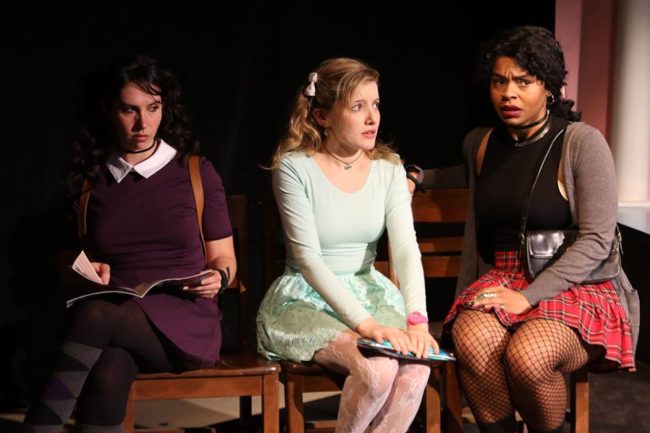
Refusing to cast the characters as written according to stature and weight, Jonas David Grey furthers his vision of keeping the play away from the issues which could so easily dominate the conversation and instead shows us an ‘everyman’ approach to these vicious lost high school demons who masquerade as teenaged girls. Tatiana Ford, Chara Bauer, and Emily Sucher, who play Renee, Patty, and Jeanine respectively, are a trio of talented performers that land Grey’s intentions without fail in this production.
Ford, who asserts that character of Renee as the unquestionable queen bee, is a viper when it comes to seizing what it is the character of Renee wants. Sassy, ferocious, and downright mean in the verbal assaults that are most frequently directed at Patty, Ford does an exceptional job of capturing that ‘mean girl’ spirit and taking it to twisted new levels of revolting. Ford’s Renee is foiled brilliantly not by the soppy Patty, but rather by Emily Sucher’s deliciously bubble-headed representation of Jeanine. Always a half-step behind and a bit slow on the uptake, Jeanine is another stereotype of high school girl drama which thrives well in Sucher’s capable hands. The pair play frenemies exceptionally well off one another and really drive a great deal of the show forward with their interactions.
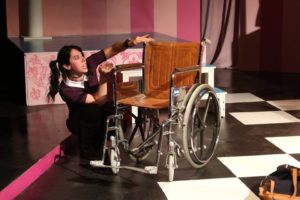
Chara Bauer, as the meek and almost meager Patty is the character with whom the audience immediately wants to empathize. Unlike the other girls, Bauer’s Patty is struggling and seeing the light at the end of the tunnel of darkness that has trapped her into her current lifestyle. There is a conviviality and a softness which Bauer brings to the table in her portrayal which almost upsets the delicate balance that Grey has created preventing this show from becoming an issues play. But the way that Bauer carries Patty off, particularly in high-stress moments— nearly all of which involve Ford’s Renee— keeps that balance in check.
The show is well worth investigating, if you can stomach it. The subject matter can be quite heavy and leave you feeling emotionally bloated, but there is more than meets the eye with what Grey and Cohesion Theatre Company are presenting with Schoolgirl Figure. Do not miss your opportunity to see this one.
Running Time: Approximately 2 hours and 20 minutes with one intermission
Schoolgirl Figure plays through December 4, 2016 at Cohesion Theatre Company at the United Evangelical Church— 3200 Dillon Street in the Canton neighborhood of Baltimore, MD. Tickets are available at the door or in advance online.

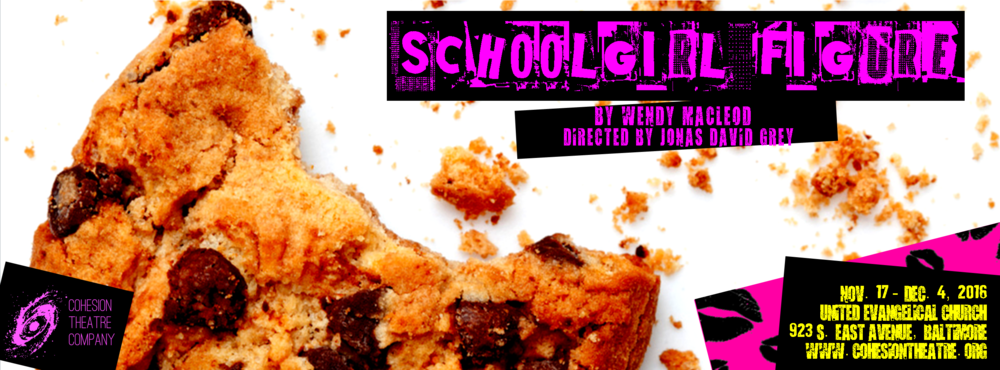
Drama which thrives in Suchers capable hands! A brilliant review! Good golly gee gosh I need to come see you in action!!! ❤️